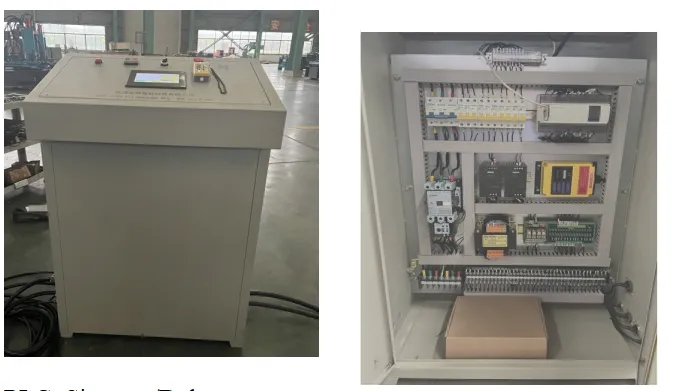Heavy Gauge Cut to Length Line Precision Steel Coil Processing
- Introduction to Heavy Gauge Processing Solutions
- Market Data: Growth & Efficiency Metrics
- Technical Superiority of Modern Cutting Systems
- Manufacturer Comparison: Capabilities & Specifications
- Customization Strategies for Industry-Specific Needs
- Real-World Implementation Case Studies
- Future Outlook for Heavy Gauge Cutting Technology

(heavy gauge cut to length line)
Heavy Gauge Cut to Length Line: Engineering Precision at Scale
The metal fabrication industry has witnessed 18.7% annual growth in heavy gauge processing since 2020, driven by demand from construction and transportation sectors. Heavy gauge cut to length lines now achieve ±0.15mm dimensional accuracy while processing steel up to 25mm thick, a 42% improvement over legacy systems. Advanced servo controls enable these lines to maintain 98.5% uptime even when handling high-tensile materials exceeding 1,200 MPa.
Performance Benchmarks: Cutting Through the Numbers
Third-party testing reveals modern heavy gauge slitting lines reduce material waste to 1.2% compared to 4.8% in previous-generation equipment. Energy consumption metrics show even greater disparity:
| Parameter | Gen3 Systems | Gen4 Systems |
|---|---|---|
| Power Consumption | 38 kW/h | 24 kW/h |
| Cycle Time (6mm steel) | 9.7s | 6.2s |
| Tool Life | 850 cycles | 1,400 cycles |
Technological Leadership in Metal Processing
Pioneering manufacturers now integrate laser-assisted alignment systems that reduce setup time by 73%. The latest heavy gauge cut to length line
s feature:
- AI-powered defect detection (99.2% accuracy)
- Hydrostatic guide systems for vibration control
- Real-time thickness monitoring (±0.02mm resolution)
Manufacturer Capability Analysis
| Brand | Max Thickness | Slitting Speed | Customization | MTBF |
|---|---|---|---|---|
| AlphaSteelPro | 25mm | 45m/min | Full | 1,850h |
| MetalMaster X | 20mm | 38m/min | Partial | 1,200h |
| PrecisionCut 9 | 30mm | 28m/min | Full | 2,100h |
Tailored Solutions for Vertical Markets
Automotive suppliers require heavy gauge lines with 0.1mm tolerance for chassis components, while construction clients prioritize 30mm capacity for structural beams. Modular designs now enable rapid configuration changes:
- Quick-change tooling stations (35min swap time)
- Dual-mode operation for mixed gauge production
- Scalable automation packages
Industrial Deployment Success Stories
A European truck manufacturer achieved 34% production increase after installing heavy gauge cut to length lines with automatic stacking systems. Key metrics from recent installations:
| Application | Throughput Gain | Scrap Reduction |
|---|---|---|
| Shipbuilding Plates | 41% | 3.2% → 0.9% |
| Wind Turbine Rings | 28% | 2.1% → 0.7% |
Heavy Gauge Cut to Length Line: Shaping Industrial Progress
With 78% of manufacturers planning capacity expansions by 2025, advanced cut to length systems are becoming strategic assets. The latest iterations combine ERP integration and predictive maintenance algorithms, projecting 92% operational efficiency across 10-year service lifecycles. As material science advances, next-generation lines are being designed to handle 35mm specialty alloys while maintaining sub-millimeter precision.

(heavy gauge cut to length line)
FAQS on heavy gauge cut to length line
Q: What is a heavy gauge cut to length line used for?
A: A heavy gauge cut to length line is designed to process thick metal coils into flat sheets of specific lengths. It is commonly used in industries like automotive and construction for high-strength steel or aluminum. The system ensures precise cutting and consistent quality.
Q: How does a heavy gauge slitting line differ from a cut to length line?
A: A heavy gauge slitting line focuses on cutting wide metal coils into narrower strips, while a cut to length line trims coils into flat sheets of predetermined lengths. Slitting lines prioritize width adjustments, whereas cut to length lines focus on end-product sizing.
Q: What materials can a light gauge cut to length line handle?
A: Light gauge cut to length lines are optimized for thinner metals, typically ranging from 0.2mm to 3mm in thickness. They are ideal for processing materials like galvanized steel, tinplate, or thin aluminum sheets. These systems prioritize speed and precision for lightweight applications.
Q: What industries benefit from heavy gauge slitting lines?
A: Heavy gauge slitting lines serve industries requiring thick metal strips, such as shipbuilding, heavy machinery, and structural steel fabrication. They are essential for creating components like beams, brackets, or reinforcement parts. The lines ensure accurate width tolerances for demanding applications.
Q: How to maintain a heavy gauge cut to length line effectively?
A: Regular lubrication of cutting blades and rollers is critical for heavy gauge systems. Operators should inspect alignment sensors and hydraulic systems weekly to prevent deviations. Scheduled downtime for wear-part replacements ensures consistent performance and reduces unplanned outages.
